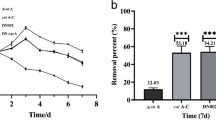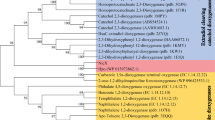Abstract
Catechol-2, 3-dioxygenase (C23O) from Pseudomonas sp. CGMCC2953 identified in our laboratory, which is one of the key enzymes responsible for phenanthrene biodegradation, was expected to get better characteristics tolerant to environment for its further application. With the aim of improving the enzyme properties by introducing intermolecular disulfide bonds, X-ray structure of a C23O from Pseudomonas putida MT-2, a highly conserved homologous with the C23O from Pseudomonas sp. CGMCC2953, was directly used to find the potential sites for forming disulfide bonds between two monomers of the target C23O. Two sites, Ala229 and His294, were identified and mutated to cysteine, respectively, by using site mutagenesis. The expected disulfide bond between these two CYS residues was confirmed with both molecular modeling and experimental results. The optimum temperature of the mutated enzyme was widened from 40 to 40∼50 °C. The mutated C23O became more alkalescency stable compared with the wild-type enzyme, e.g., 75% of the maximal enzyme activity retained even under pH 9.5 while 50% residue for the wild-type one. Improvement of thermostability of the mutated C230 with the redesigned disulfide was also confirmed.








Similar content being viewed by others
References
Zhou, Y., Wei, J. S., Jiang, T., Gao, W. F., Ma, Y. S., & Wei, D. Z. (2007). Characterisation of a thermostable catechol-2, 3-dioxygenase from phenanthrene-degrading Pseudomonas sp. strain ZJF08. Annals of Microbiology, 57, 503–508.
Folsom, B. R., Chapmane, P. J., & Pritchard, P. H. (1990). Phenol and trichloroethylene degradation by pseudomonas cepacia G4; kinetics and interactions between substrates. Applied and Environmental Microbiology, 56, 1279–1287.
Takehiro, K., Tetsuo, I., Kihachiro, H., Yoshiyuki, T., Naganori, N., Atsushi, N., et al. (1995). Overexpression of pseudomonas putida catechol 2, 3-dioxygenase with high specific activity by genetically engineered Escherichia coli. Journal of Biochemistry, 117, 614–622.
Gibson, D. T., & Parales, R. E. (2000). Aromatic hydrocarbon dioxygenases in environmental biotechnology. Current Opinion in Biotechnology, 11, 236–243.
Boyd, D. R., Sharma, N. D., & Allen, C. C. R. (2001). Aromatic dioxygenases: molecular biocatalysis and applications. Current Opinion in Biotechnology, 12, 564–573.
Harayama, S., & Rekik, M. (1989). Aromatic ring-cleavage enzymes are classified into two gene families. Journal of Biological Chemistry, 164, 15328–15333.
Moon, J., Chang, H., Min, K. R., & Kim, Y. (1995). Cloning and sequencing of the catechol 2, 3-dioxygenase gene of Alcaligenes sp.KF711. Biochemical and Biophysical Research Communications, 208, 943–949.
Meyer, S., Moser, R., Neef, A., Stahl, U., & Kämpfer, P. (1999). Differential detection of key enzymes of polyaromatic-hydrocarbon-degrading bacteria using PCR and gene probes. Microbiol, 145, 1731–1741.
Okuta, A., Ohnishi, K., Yagame, S., & Harayama, S. (2003). Intersubunit interaction and catalytic activity of catechol 2, 3-dioxygenases. Biochemical Journal, 371, 557–564.
Nozaki, M., Ono, K., Nakazawa, T., Kotani, S., & Hayashi, O. (1968). Metapyrocatechase. II. The role of iron and sulfhydryl groups. Journal of Biological Chemistry, 243, 2682–2690.
Bartels, I., Knackmuss, H. J., & Reineke, W. (1984). Suicide inactivation of catechol-2, 3-dioxygenase from Pseudomonas putida mt-2 by 3-halocatechols. Applied and Environmental Microbiology, 47, 500–505.
Cerdan, P., Wasserfallen, A., Rekik, M., Timmis, K. N., & Harayama, S. (1994). Substrate specificity of catechol-2, 3-dioxygenase encoded by TOL plasmid pWW0 of Pseudomonas putida and its relationship to cell growth. Journal of Bacteriology, 176, 6074–6081.
Betz, S. F. (1993). Disulfide bonds and the stability of globular proteins. Protein Science, 2, 1551–1558.
Wedemeyer, W. J., Welker, E., Narayan, M., & Scheraga, H. A. (2000). Disulfide bonds and protein folding. Biochem, 39, 4207–4216.
Kita, A., Kita, S., Fujisawa, I., Inaka, K., Ishida, T., Horiike, K., et al. (1999). An archetypical extradiol-cleaving catecholic dioxygenase: the crystal structure of catechol 2, 3-dioxygenase (metapyrocatechase) from Ppseudomonas putida mt-2. Structure, 7, 25–34.
Sowdhamini, R., Srinivasan, N., Shoichet, B., Santi, D. V., Ramakrishnan, C., & Balaram, P. (1989). Stereochemical modelling of disulfide bridges: criteria for introduction into proteins by site-directed mutagenesis. Protein Engineering, 3, 95–103.
Liu, J., Wang, Y., Liu, G., & Zhang, B. (2004). Comparison of three methods for determination of glutathione. Journal of Beijing University of Chemical Technology, 31, 35–38.
Baker, D., & Sali, A. (2001). Protein structure prediction and structural genomics. Science, 294, 93–96.
Zhang, Y. (2008). Progress and challenges in protein structure prediction. Current Opinion in Structural Biology, 18, 342–348.
Winkler, J., Eltis, L. D., Dwyer, D. F., & Rohde, M. (1995). Tetrameric structure and cellular location of catechol 2, 3-dioxygenase. Archives of Microbiology, 163, 65–69.
Author information
Authors and Affiliations
Corresponding author
Rights and permissions
About this article
Cite this article
Wei, J., Zhou, Y., Xu, T. et al. Rational Design of Catechol-2, 3-dioxygenase for Improving the Enzyme Characteristics. Appl Biochem Biotechnol 162, 116–126 (2010). https://doi.org/10.1007/s12010-009-8720-y
Received:
Accepted:
Published:
Issue Date:
DOI: https://doi.org/10.1007/s12010-009-8720-y




